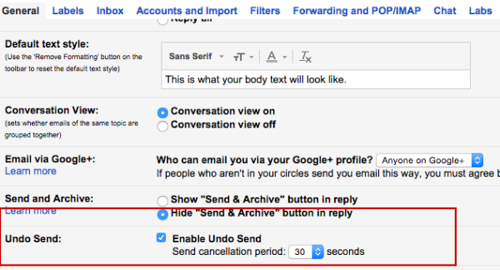
This post first appeared on the Ferenstein Wire, a syndicated news service; it has been edited. For inquires, please email author and publisher Gregory Ferenstein.
Google has officially added the ability to “un-send” emails to its Gmail email service, letting users retrieve messages for a short period after they send them. While not exactly new—it was an experimental Gmail Labs feature long popular with power users—the move now makes it a bona fide capability.
I use it daily to correct emails riddled with grammar errors or, worse, messages that I should never have sent at all.
The ‘undo’ feature happens to pair delightfully well with the favorite email strategy of Google executive Eric Schmidt: replying to important messages immediately and constantly throughout the day. But replying quickly to every message both increases the likelihood of thoughtlessly sending a stupid message and wastes a lot of time weeding through spam.
Fortunately, Google’s recently released mobile app, Inbox, makes easier work of it, as the app can both algorithmically sort important messages and now includes the unsend feature. Altogether, the company has now set up a deliciously effective email trifecta for managing a swelling inbox.
Undo, Don’t Be Undone

Gmail’s undo feature grants users an opportunistic window of 5–30 seconds to “unsend” a message. On desktop, Gmail displays a bold “undo” button at the top of the browser, waiting for the user to do nothing before it automatically shoots off the message. I’ve been using this life-saving feature daily since the company first offered it as an experimental feature in 2009.
Happy Gmail users can now enable this in Gmail settings.

Knowing how to “undo” sent emails is one thing. Letting it support smarter communications is another.
In Schmidt’s new book, How Google Works, he outlined 9 tips that he uses to manage a multi-billion dollar company. His first piece of advice is to respond right away, even with pithy replies, rather than wait until you have time to write eloquent messages. A short excerpt:
Respond quickly: There are people who can be relied upon to respond promptly to emails, and those who can’t. Strive to be one of the former. Most of the best — and busiest — people we know act quickly on their emails, not just to us or to a select few senders, but to everyone.
UC Irvine Professor Judy Olson agrees. Olson finds that quick responses are essential to building trust between teams. With digital messages, there’s no body language to inform the conversation. So people often psychologically substitute speedy responses as a proxy for trust. Wait too long to reply, and the recipient starts to wonder if the sender is secretly angry or disinterested.
Creating A Rapid Messaging Strategy
Responding quickly to messages on the desktop can be much easier than on smartphones, thanks to those roomy physical keyboards. But we tend to have phones on us at all times, which makes them the devices most in need of a rapid messaging strategy.
Fortunately, the new “un-send” feature also extends to Google’s new mobile app, Inbox, which offers another helpful aspect: Like Gmail on the Web, the app supports Priority Inbox, which algorithmically sorts messages according to its importance to you (or what it thinks is important). Separating newsletters, promotions and junk from the equation helps keep you focused on messages that require a response.
Priority Inbox takes some training, but I’ve found that it does a superb job of filtering out spam and mass messages.
I also enable push notifications in my phone’s settings menu. This ensures my device buzzes me immediately for important messages, so I can reply right away.
This strategy, plus the safety net of “undo,” makes the chore of slogging through messages much less painful. Happy emailing!
For more stories, subscribe to the Ferenstein Wire newsletter here.

















